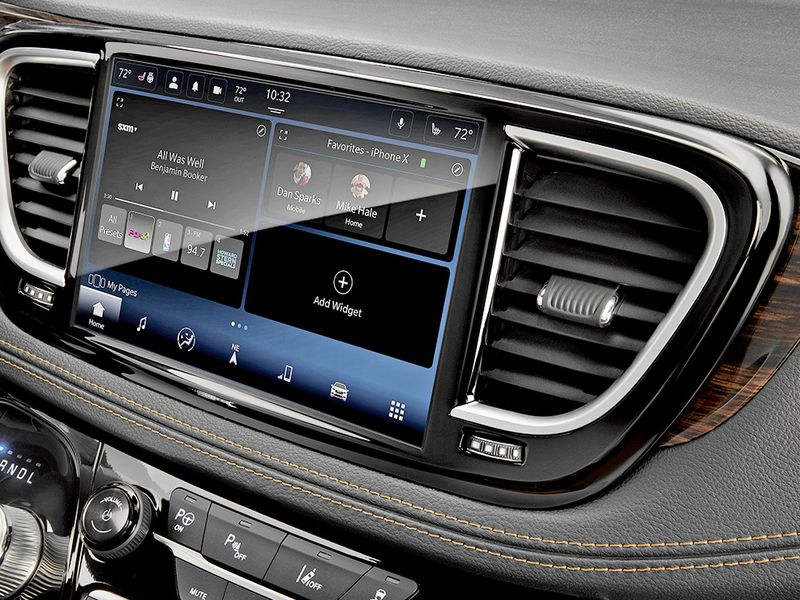
When drivers start up the 2021 Chrysler Pacifica and Dodge Durango this fall, they’ll be introduced to the next-generation version of Fiat Chrysler Automobiles’ heralded Uconnect infotainment system.
The latest iteration, Uconnect 5, runs on an Android-based operating system and has processing speeds five times faster than those of its predecessor. It enables two Bluetooth phones to connect simultaneously, aiding those who carry multiple phones and allowing passengers to interact with the system in addition to the driver.
Getting the system ready in time for vehicle launches became a tougher task than expected after the coronavirus pandemic forced designers to rearrange their working conditions on the fly. And the experience could leave a lasting imprint on how designers go about their duties in the future.
The crew of about 30 employees had to finish tuning Uconnect 5, which was far along in its development, using standalone prototype units in home offices. The team usually operated with a few prototypes at FCA’s suburban Detroit headquarters but suddenly needed a few dozen with everyone separated.
Vince Galante, FCA’s chief designer of user experience, said he might keep a standalone unit at home from now on — even after he eventually goes back to working at the office.
“I get software updates once a week, for sure, sometimes twice a week,” he told Automotive News. “We get on calls and we talk about it, we look at it. We update, we tweak, we get a new software download and we’ve been doing that for six, seven months now.”
The design team has been making a lot “fine adjustments” such as ensuring that the selected screen colors work and that the contrast is right so everything is easy to read.
Response time is another key piece in making Uconnect 5 intuitive. This was evident in the system’s “card-based format” that allows users to personalize and simplify display screens. Users can group features into different screens to determine how and where each is displayed.
By touching one of the cards and holding it for a second, a user can move it into different positions on the screen. Getting the timing right required a delicate balance.
“We started off with, like, 2 seconds, and that just felt too long,” Galante recalled. “We went down to half a second; it was too quick. And so we’ve been doing little adjustments like that. Really fine-tuning to make sure that all those things [are] put in there to make it really easy to use, to make sure they’re working right, exactly how they should be. Those are some of the small adjustments we’re making, but they’re really, really important for when the customer is finally using it.”
As team members made changes, Galante would get texts alerting him to try it out on his prototype. He said this is the way they have to work. Speed is critical.
In fact, working that way might even be a little quicker in some aspects, Galante said. Relaying ideas, which may have required a presentation previously, can be as simple as zipping texts back and forth.
“It would have taken a little bit of time,” Galante said. “Now that we’re so used to this really iterative, quick communication, [I] just get a text. Before, they’d have to prepare something, and now it’s like, ‘No, no, he’s there, he’s available, let’s just ask.’ ”
While the home prototypes have been invaluable to refining the system, the true proving ground is the vehicle itself. Uconnect 5 appears to be passing that test with Galante’s children, ages 9 and 6.
The youngsters jumped in a Jeep Grand Cherokee equipped with the prototype unit and learned the system within a few seconds.
“I just put it in front of them, and they’re very curious. They were making pages and changing widgets and moving things around. I didn’t have to say a thing,” Galante said. “As soon as I saw that — I mean it was 30 seconds and they had their own screens built. I said to myself, ‘OK, I think we got something here.’ ”
Galante’s mother got in on the act, too, and was able to pick up on the intricacies of the system.
Working from home, he said, has yielded an unforeseen benefit.
“Designers, when you’re more comfortable, when you’re more in your element, it’s a little easier to be even more creative, come up with new ideas and do all those things,” he said. “A nice surprise of all this has been all of us designers are in our comfort zone. I’ve actually seen an explosion of creativity that I didn’t expect.”